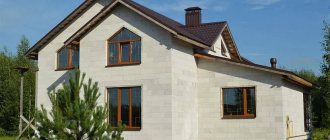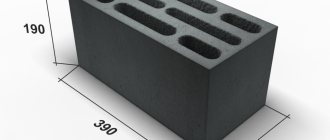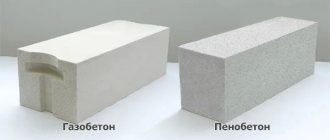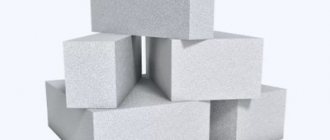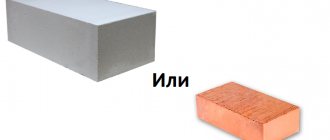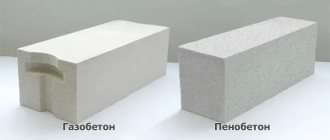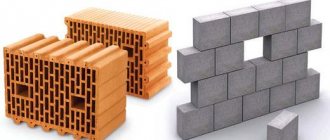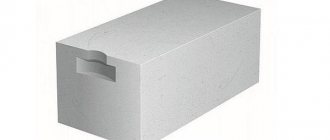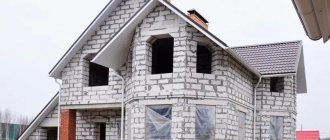SHARE ON SOCIAL NETWORKS
FacebookTwitterOkGoogle+PinterestVk
The rapidly developing construction industry constantly requires the emergence of new technologies and materials. Therefore, many are wondering which blocks are better for building a house, since they are the ones that have recently enjoyed the greatest popularity and compete at a high level with the long-known brick. The emergence of a new type of masonry raw material was caused mainly by the desire to speed up the construction process and reduce its labor intensity.
Various types of building blocks can be used to construct a residential building.
What are the types of blocks for building a house: main types and characteristics
The larger dimensions of building blocks, compared to bricks, make it possible to lay masonry several times faster, and their relatively low weight greatly facilitates the work. This quality gave a significant impetus to their introduction to the market.
Large block sizes allow construction to be carried out quickly and easily
There are several classifications of blocks for construction. Depending on the dimensions of the product, they can be divided into the following groups: small-sized and large-sized. The first group includes products with small dimensions, low strength and heat conductivity. The second group will be represented by products with large sizes and high strength values, as well as average insulating characteristics.
Higher quality building blocks are classified by the type of material used to make them. The main component of all types is invariably concrete. Only minor materials and production technology vary.
The following groups can be distinguished here:
- concrete;
- expanded clay concrete;
- gas silicate;
- aerated concrete;
- foam concrete;
- polystyrene concrete;
- slag concrete;
- arbolite;
- ceramic.
3D visualization of a two-story cottage built from blocks
Defining characteristics and their influence on consumer choice
Considering in more detail all types of blocks for construction, you need to dwell on their main technical characteristics. These are density, thermal conductivity, compressive strength, frost resistance. They are the determining factors when choosing the right material. Based on these parameters and dimensions, the correct calculation of the number of blocks for building a house is made.
It is always worthwhile to clearly think through all types of work, since different blocks are suitable for specific purposes. You need to focus on a certain course: will it be just insulation, a partition, or a more massive supporting structure. What type of building will this material be applied to: capital construction in the form of, for example, a house or garage, or a simpler version of a summer shower or outbuilding. And of course one more factor: how much the blocks cost to build a house.
Radioactivity
Perhaps the most ridiculous myth regarding the material. Aerated concrete is no more (even less) radioactive than wood or gypsum ( Aeff = 54 Bq/kg) and corresponds to class 1 5 in terms of the total specific activity of natural radionuclides. ( 5 is prohibited because Aeff > 370 ).
Concrete blocks: performance characteristics and scope of application
This type of blocks was the very first on the production line. It is very common in use, especially where high construction strength is required. Depending on the brand of concrete used, the following groups can be distinguished: FBS, FBV and FBP.
Concrete blocks are the most popular in the building materials market
There is a state standard in which the sizes of blocks for construction are clearly regulated. This makes it possible to accurately calculate the costs of building construction. The above brands may have a solid structure or longitudinal cutouts intended for laying communications.
The most significant advantage of these types of blocks is their ease of use. In most cases, they are applicable for laying the foundation. Thus, when using this particular technology, the process can be significantly simplified. There is no need to pour concrete, involving a lot of additional equipment, and you will not have to wait until it hardens to continue further work.
The price of concrete blocks measuring 390x190x188 mm, differing only in the number of slots in their structure, ranges from 40 to 55 rubles/piece. Smaller sizes 390x80x188 and 390x90x188 mm cost from 25 to 30 rubles/piece.
Construction of a residential building from concrete blocks
Dimensions of warm ceramics from popular manufacturers
Braer
Domestic manufacturer with production facilities in the Tula region. During the manufacturing process, the raw material undergoes multi-stage cleaning and processing. Strict quality control of the raw materials used eliminates the presence of impurities.
The workshops are equipped with modern European equipment with automatic control, eliminating defects. Each production stage is accompanied by control tests, during which the product's compliance is checked for strength, voids, moisture and weight.
A mandatory procedure is checking products for compliance with GOST requirements. Braer blocks, each of which has a brand quality mark, are characterized by uniformity of composition and uniformity of voids, strict adherence to shape and geometric dimensions. In order to increase safety when transporting products, special pallets are used.
| Block name | Length, mm | Width, mm | Height (thickness), mm |
| Ceramic block Braer 51 (additional) | 510 | 130 | 219 |
| Ceramic block Braer 38 (additional) | 380 | 130 | 219 |
| Ceramic block Braer 51 | 510 | 250 | 219 |
| Ceramic block Braer 44 | 440 | 250 | 219 |
| Ceramic block Braer 38 | 380 | 250 | 219 |
Wienerberger
An Austrian company whose products are characterized by high quality workmanship. The manufacturer specializes in the production of large-format ceramic blocks. Due to the high strength of the material, it is used for the construction of residential and other buildings whose height reaches 4 floors. At the same time, it is perfectly combined with other facing and finishing materials, ensuring the construction of objects of any style and level of complexity.
A special feature of Austrian stone with strength class M100-M150 is its high vapor permeability and resistance to ultraviolet radiation.
| Block name | Length, mm | Width, mm | Height (thickness), mm |
| Porotherm 12 | 500 | 120 | 219 |
| Porotherm 20 | 400 | 200 | 219 |
| Porotherm 25 | 375 | 250 | 219 |
| Porotherm 25M | 375 | 250 | 219 |
| Porotherm 30 | 300 | 250 | 219 |
| Porotherm 38 | 380 | 250 | 219 |
| Porotherm 38 1/2 | 380 | 250 | 219 |
| Porotherm 38 Thermo | 380 | 250 | 219 |
| Porotherm 44 | 440 | 250 | 219 |
| Porotherm 44 1/2 | 440 | 250 | 219 |
| Porotherm 44 GL (Green Line) | 440 | 250 | 219 |
| Porotherm 44R | 440 | 180 | 219 |
| Porotherm 51 | 510 | 250 | 219 |
| Porotherm 51 1/2 | 510 | 250 | 219 |
| Porotherm 8 | 500 | 80 | 219 |
LSR
This brand unites 4 large enterprises producing wall blocks. Raw materials extracted from our own quarries are subject to strict control. At a more favorable price for the Russian consumer, the product quality is not inferior to European analogues.
| Block name | Length, mm | Width, mm | Height (thickness), mm |
| Ordinary porous stone 2.1 NF GOST 530-2012 | 250 | 120 | 140 |
| Ordinary partition stone 4.58NF | 510 | 80 | 219 |
| Ordinary partition stone 6.9NF | 520 | 120 | 219 |
| Ordinary hollow stone 8.98 NF | 400 | 200 | 219 |
| Ordinary porous stone 10.7 NF GOST 530-2012 | 380 | 250 | 219 |
| Ordinary porous stone 11.2 NF GOST 530-2012 | 398 | 250 | 219 |
| Ordinary porous stone 14.3 NF GOST 530-2012 | 510 | 250 | 219 |
| Ordinary porous stone 10.7 NF warm GOST 530-2012 | 380 | 250 | 219 |
| Ordinary porous stone 12.35 NF GOST 530-2012 | 440 | 250 | 219 |
Stalingrad stone
The production belongs to a Russian industrial holding company that produces building materials. The stones produced are characterized by precise geometry and high performance parameters. Large-format blocks are used in the construction of industrial and residential facilities, undergo strict control for compliance with GOST and are subject to mandatory certification.
| Block name | Length, mm | Width, mm | Height (thickness), mm |
| THERMOBLOCK 44 (12.4 NF) | 440 | 250 | 219 |
| THERMOBLOCK 38 (10.7 NF) | 380 | 250 | 219 |
| THERMOBLOCK 25 (10.7 NF) | 380 | 250 | 219 |
| THERMOBLOCK 38 (9.3 NF) | 380 | 250 | 188 |
| THERMOBLOCK 20 (9.0 NF) | 400 | 200 | 219 |
| THERMOBLOCK 8 (4.4 NF) | 490 | 80 | 219 |
| THERMOBLOCK 8 (6.7 NF) | 490 | 80 | 335 |
Gzhel
The trademark belongs to JSC Gzhel Brick Plant. The company's core specialization is the production of porous stone and ceramic bricks. The history of the plant dates back to 1928. During this time, the enterprise has undergone modernization more than once; new technologies are constantly being introduced into the production process.
Ceramic blocks are produced using European equipment from Bedeschi SpA; clay from the Gzhel deposit, which is environmentally friendly, is used as raw material. Warm ceramics GKZ is a reliable and durable material, the production stages of which are subject to strict control.
| Block name | Length, mm | Width, mm | Height (thickness), mm |
| Large format block 10.7 NF LUX | 380 | 250 | 219 |
| Porous stone 2.1NF | 250 | 120 | 140 |
| Large format block 12.3 NF 440mm | 440 | 250 | 219 |
| Large format block 14.3 NF 510mm | 510 | 250 | 219 |
| Large format block 10.7 NF 250 mm | 380 | 250 | 219 |
| Large format block 10.7 NF 380 mm | 380 | 250 | 219 |
| Ceramic stone 9.0NF | 400 | 200 | 219 |
| Ceramic stone 6.8NF | 510 | 120 | 219 |
| Ceramic stone 4.5NF | 510 | 80 | 219 |
Expanded clay concrete blocks: properties, advantages and disadvantages
In the manufacture of expanded clay concrete blocks, expanded clay is used as an admixture. It is a porous material produced in the form of granules by firing clay. This mixture gave very unusual properties to new types of blocks, thanks to which they gained due recognition among the consumer.
By varying the amount of filler, the end result is a block of varying strength. This leads to an expansion of the range of applications of this material. The most popular density is from 500 to 1800 kg/cm³. The denser the material, the stronger it is and can be used for multi-story buildings.
The construction of houses from expanded clay concrete blocks has a number of positive qualities. Buildings do not deform, do not shrink, and do not crack. Low production cost is also a plus. The availability of sufficient quantities of the starting material and the low technological cost of production generally provide maximum benefits from its use.
Expanded clay concrete block has dimensions 390x90x188 mm
Note! Precisely because the production of expanded clay concrete blocks does not require large material costs, many try to make it themselves using the “handicraft method”. Failure to comply with some necessary standards results in low-quality material and inappropriate block sizes for construction. Therefore, when purchasing this product, you must make sure of the good reputation of the manufacturer.
This block also needs to be insulated with finishing materials, and from the outside. This will have a positive effect of increasing thermal conductivity, and will also increase the service life of the building.
The price of expanded clay concrete blocks depends on their size and purpose. For a hollow wall block, the dimensions of which are 390x190x188 mm, it ranges on average from 33 to 50 rubles/piece. and directly depends on the number of voids-cracks in the material.
The solid block has the most popular dimensions of 390x190x188 mm, and its price is slightly higher, about 57 rubles/piece. The partition type of this type is most often presented in the size of 390x90x188 mm and the price range ranges from 25-30 rubles / piece.
Construction of a house from expanded clay concrete blocks
Specifications
Mechanical characteristics are specified in GOST 6133-99 , 10180-90 and 12730.1-78 .
The energy saving options are as follows:
The key parameter of any masonry material is thermal conductivity, which in our case depends linearly on the density of the building block.
| Density, kg/m3 | Thermal conductivity coefficient, W/(mS) |
| 1800 | 0,81–0,90 |
| 1600 | 0,66–0,78 |
| 1400 | 0,57–0,64 |
| 1200 | 0,45–0,53 |
| 1000 | 0,32–0,42 |
| 800 | 0,25–0,32 |
| 600 | 0,21–0,27 |
| 500 | 0,18–0,24 |
The vapor permeability of the material is comparable to wood and drywall. Aerated concrete “breathes” 2 times better than brick.
| Density, kg/m3 | Vapor permeability, mg/(m h Pa) |
| 1400 | 0,094 |
| 1200 | 0,108 |
| 1000 | 0,138 |
| 800 | 0,187 |
| 600 | 0,256 |
Gas silicate blocks and the main criteria for their use
The construction of houses from gas silicate blocks has become very popular recently. The material itself, aerated concrete, is made from cement, quicklime, quartz sand and aluminum powder using the autoclave method under certain temperatures and pressure. In the process of mixing these components, a large amount of hydrogen is released, which, when solidified, gives the finished product a cellular structure.
Advantages and disadvantages of gas silicate blocks
The positive qualities of gas silicate blocks are as follows:
- they have a small mass and therefore the construction will be much easier than, for example, from brick. This property makes it possible to reduce pressure on the foundation. This means that the skeleton itself can be planned to be less capital, which significantly saves money;
- a low level of thermal conductivity will provide a higher temperature in the interior;
- The variety of shapes and sizes makes this material in demand. Without limiting themselves to specific size ranges, manufacturers are expanding the range of consumption. The design with additional recesses and groove connections is also quite popular;
Gas silicate block is a popular material for building houses
- the large dimensions of the gas silicate block for building a house and their clear, even edges significantly speed up the construction process;
- the use of special adhesive mixtures for masonry, which are simply diluted with water in a certain proportion, also saves time;
- Due to its structure, gas silicate is easy to saw, process, and lay all kinds of grooves;
- high fire resistance comes first in safety matters.
Despite a number of the above positive qualities, several negative ones can be identified: the cellular structure of the material gives not only advantages, but also disadvantages. It clearly reduces the density indicator, the level of compression and stretching. Therefore, the maximum number of floors of such buildings should not exceed 2. Otherwise, experiencing a large load, the lower rows will begin to collapse and shrink. The appearance of cracks is possible.
Note! To increase the strength of the walls, experts recommend strengthening the building with steel reinforcement.
Construction of a wall using gas silicate blocks
Blocks of this type in the size range 60x25x50 and 60x25x40 mm cost on average from 30 to 206 rubles/piece. Increasing the last parameter increases the price. Sizes 60x30x10, 60x30x20 and 60x30x25 cost 30, 58 and 75 rubles/piece. respectively. The most expensive are the largest ones - 60x37.5x25 mm, which have a price of 210-233 rubles / piece. and 60x40x25 mm – 225-240 rub./piece.
Installation of blocks
The process of laying blocks is almost the same as installing bricks, only the size of the mortar joints in this case is about 10-12 centimeters. To increase the stability of the building and the strength of the walls, the structure is reinforced with reinforcement. Typically, laying begins from the corners of the building - this way it is possible to achieve maximum accuracy in following the project.
During the installation of wall and ventilation blocks, sections for building partitions, the height and level of each laid row of stone must be checked. An ordinary building level or a string stretched between the end and the corner will be sufficient.
If a wall made of concrete products is mounted with voids, be sure to lay a board in their place to avoid the concrete mixture getting into the voids that appear. In the process of laying each next row, simply raise the board higher. The sections for partitions are installed in the same way. Blocks that are too heavy are installed using special equipment - the means should be taken care of in advance.
The laying of the basement walls is no different - the sections are mounted in the same way. Only the top row of stone must be tied to the foundation of the building or the floor.
The work uses special tools and a concrete mixture prepared from components mixed in certain proportions.
The mixture must be used immediately, as it hardens quickly. Despite the fact that laying reinforced concrete blocks is not very difficult, experienced craftsmen advise turning to professionals who will do everything quickly and efficiently.
Construction of houses from aerated concrete blocks: advantages and disadvantages
Just as in the case of using aerated silicate blocks, construction from aerated concrete begins with determining what needs to be obtained in the end: main walls, partitions of a two-story massif, or insulation of existing buildings. Based on the tasks set, you just need to buy blocks to build a house of the required density. And also take care of the external decoration of the walls. It should provide not only an acceptable appearance of the structure, but also minimize the moisture absorption coefficient.
Aerated concrete blocks are produced using the autoclave method. They consist of cement, lime, gypsum and aluminum powder. As in the case of the gas silicate type, a massive chemical reaction occurs between the constituent components, resulting in the release of hydrogen, due to which the cellular structure of the material is obtained.
Various sizes and shapes of aerated concrete blocks
After complete hardening, aerated concrete is cut into blocks of the required size for building a house using a string. Therefore, the resulting result is distinguished by ideal geometrically smooth edges. This is important, since during laying there will be very few gaps at the seams, which will provide an additional percentage of heat.
This type of block has another attractive property. Thanks to its special structure, it can be easily cut with a regular saw. In this way, you can quickly adjust the parameters and obtain the desired size of an aerated concrete block for building a house.
Related article:
Beautiful houses: projects with successful design and interior layout
Cottages with a unique design and popular architectural solutions. Tips for developing and choosing the optimal building layout for living.
Pay attention to the marking: the main selection parameter
Aerated concrete blocks are very popular today. Numerous offers from manufacturers provide the opportunity to use this material not only for walls, but also for ceilings, lintels for windows and doors. A large size range makes it possible to build the entire structure from these blocks.
Just like other types of blocks, aerated concrete products can have mounting grooves for ease of use. Such a connection will give maximum fit and the desired thermal conductivity.
Aerated concrete block can be easily cut with a regular hacksaw
When choosing the required material, pay attention to the markings. It is designated by the Latin letter D and the numbers following it. These numbers indicate the density of the block. Thus, the most applicable brands are D500-D900, which with a size of 600x250x200 mm weigh 18 kg and thus can replace 20 pcs. bricks.
Fire safety
Low thermal conductivity ( GOST 31359 and GOST 30244 ) allows aerated concrete to be classified as a non-flammable building material of the fire hazard class - K0 (non-fire hazardous).
100 thick wall D500 brand blocks is capable of resisting fire for 3 1 fire barrier and used as a barrier to increase the degree of fire resistance of any building structures.
Foam concrete: optimal price-quality ratio
Concrete block is a cellular type of building material. All their qualities are inherent in him. It is made from a mixture of concrete and foaming agent. The foam is prepared in a special generator and then poured directly into the cement. It envelops and thereby closes all cells in the structure. Afterwards, the mixture enters special cassettes and remains to solidify at natural ambient temperature. There is no special thermal effect on this material.
Note! Foam concrete needs to “stand” for an average of 28 days from the date of manufacture in order to finally harden and obtain the necessary strength.
Foam concrete block with facing side
Many developers note the favorable price of blocks for building a house: any private developer can buy foam concrete products. At the same time, they make it possible to easily display, for example, any figured arches or partitions.
When considering the question of which blocks are better for building a house: gas and foam concrete are often compared. There is no clear answer to this question, but there are a few things to consider:
- aerated concrete blocks look like a sponge. Their pore cells are not closed, as a result they actively absorb and retain moisture that gets into them. In this regard, foam blocks with cells that are completely closed and concentrated exclusively inside are in a more advantageous position;
- if we apply sub-zero ambient temperature to the absorbed moisture, we will get a disappointing result for the aerated block: it will crack and shrink;
- Foam concrete has a lower density; it contains more cells that are filled with air. Therefore, it retains heat much better;
- For the production of aerated concrete blocks, more professional equipment is used, which makes it possible to have clear dimensions and correct edges of the products.
The most popular size of foam concrete block is 600x300x200 mm
A foam concrete block, depending on its density in the most popular size 600x300x200 mm, costs from 95 to 120 rubles/piece. Naturally, high-density material has the highest price. If you increase at least one of the dimensional parameters, for example, to 600x400x200 mm, then the price will be 120-170 rubles/piece.
Acceptable defects in appearance
Parameters such as the types of front faces and the color of the porous block are agreed upon in advance by the customer and the manufacturer and specified in the delivery document. A prerequisite for facing products is the presence of two or more facing edges (spoon and butt).
Ordinary stones can have embossed or smooth vertical edges.
Facial materials come with:
- smooth and embossed front surface;
- with a surface subject to such types of processing as shotcrete, glazing, engobing, two-layer formation, etc.
The material can be painted in a volumetric way or have a natural color.
Facial stones may include single swellings, the depth of which does not exceed 3 mm. In this case, the area of inclusions should not exceed 0.2% of the area of the front faces. For ordinary materials, the area of permissible swelling inclusions should not be more than 1% of the area of the vertical edges.
Block materials that have defects in appearance exceeding the values specified in the table below are not allowed for use.
Table: defects in the appearance of the product
| Type of defect | Meaning | |
| Facial Products | Ordinary products | |
| Broken corners in depth, broken edges and edges longer than 15 mm, pcs. | Not allowed | 4 |
| Broken corners in depth, broken edges and edges with a length of no more than 15 mm, pcs. | 2 | Not regulated |
| Individual cuts with total length, mm, no more: | 80 | Not regulated |
| Cracks, pcs. | Not allowed | 4 |
Notes:
- Signs of defects do not include chips whose depth is less than 3 mm.
- Cracks in inter-cavity partitions, cracks and breaks in tongue-and-groove joints are not considered defects.
- Defects in the face stones were identified in relation to the face faces.
- Acceptable are the presence of contact spots on the surface and a black core.
- Half of more than 5% of the batch volume is not acceptable.
According to the Construction Dictionary: Half - Broken in half or into smaller pieces.
Which blocks to choose for building a house: advantages and disadvantages of polystyrene concrete
This type of blocks appeared relatively recently on the building materials market. It is deservedly popular among developers. Its following characteristics are very important:
- low thermal conductivity;
- soundproofing;
- reliability;
- frost resistance;
- environmental cleanliness.
Polystyrene concrete has high sound insulation qualities
The manufacturing process takes place both in industrial conditions and at home. A mixture of polystyrene granules, cement, sand and hardening additives is poured into a concrete mixer in a clearly defined sequence and mixed. Then they are poured into pre-prepared molds to harden for about a day under natural conditions. After 24 hours, the blocks can be removed and carefully laid out on a flat surface until completely dry.
All polystyrene concrete blocks can be divided into two types:
- with cladding. They do not require additional finishing of the facade, since one side can be made in the form of stone, marble or granite. An important point is the absence of any additional adhesives. This facing layer is part of the concrete;
- ordinary blocks that are used to build walls. The cost of blocks for building a house made of polystyrene concrete is approximately half the cost of bricks.
A polystyrene concrete block measuring 600x300x250 mm has a price of 120-160 rubles/piece. A smaller block measuring 390x190x188 mm costs 40-50 rubles/piece.
The composition of a polystyrene concrete block includes polystyrene granules, cement, sand and various additives
Almost all the negative aspects of using this type of material depend on the correctness of its manufacture. If the blocks were made without strictly following the rules, then the possibility of microcracks and shrinkage increases significantly.
Plus, it is necessary to add special fibers to ensure a durable product. If you skimp on these fibers, you end up with a block that doesn’t justify itself. All this must be taken into account when purchasing.
Main disadvantages
The disadvantages of expanded clay concrete blocks include the following characteristics:
- the need to use facing materials;
- fragility, requiring care during transportation, installation and handling;
- the impossibility of constructing facilities in regions with high levels of humidity, since due to porosity and temperature fluctuations, the expanded clay block will collapse before its expected service life, or it will be necessary to provide a high level of waterproofing;
- It is prohibited to use blocks to lay a monolithic foundation;
- the appearance of cold bridges in joints requires the use of blocks with precise geometry and high-quality cement-sand mortars;
- buildings must be heated during the cold season to prevent freezing.
How to reduce the influence of negative factors?
If negative factors are critical, then you should not refuse to choose expanded clay concrete for the construction of facilities. There are several methods to reduce their influence:
- if it is necessary to install hydro- and heat-insulating materials, ventilated facades should be formed, which will ensure sufficient air exchange and prevent the accumulation of moisture inside the expanded clay block, accordingly, the likelihood of freezing will be minimized;
- when constructing buildings from 2 floors and above, it is necessary to frame the walls, as well as laying reinforcing metal mesh every 3-4 rows;
- a one-story building can be built half the width, but with insulation, thus reducing construction costs by 30-40%.
Special qualities of slag and its use in the slag concrete industry
The product obtained after severe heat treatment of any raw material is called slag. It is an alloy of oxides. When using slag for the production of concrete blocks, the material is taken without any additional chemical compounds.
Hollow cinder block is ideal for building walls and partitions
It is important to properly prepare the slag for use. It should lie in the open air for about six months. This will allow natural precipitation to wash out the remaining impurities of sulfur and lime. It will be good if it is moved from place to place several times. This action will also help to weed out everything unnecessary.
The production of slag concrete blocks uses slag sand (it gives additional density) and crushed stone (it gives additional lightness). The finished products contain about 2/3 cement and 1/3 lime, plus the required amount of slag.
If all necessary norms and requirements are met, the price of blocks for building a house will be very reasonable. It turns out to be a good price-quality ratio.
The main characteristics of these blocks are their strength grade and density. The following brands are distinguished:
- M10 – used for insulation;
- M25 and M 35 - suitable for the construction of partitions of low load-bearing capacity;
- M50 and higher are used for the construction of load-bearing walls.
Cinder blocks of grade M50 and higher are used for the construction of load-bearing walls
Pros and cons of cinder blocks
The advantages of slag concrete blocks over brick are their relatively light weight. Less pressure is created on the foundation and other supporting structures. This extends the service life of buildings. Like other types of blocks, they significantly speed up the construction process due to their size.
Disadvantages can be identified even at the production stage: a long time to prepare the material itself, and a long time to achieve the desired hardening rate. Only after a month does it reach only 50% of this value. It will take him a year to fully comply.
The cinder blocks used for interior partitions have a size of 390x90x190 mm and cost 17-35 rubles/piece. For buildings for various purposes, products with dimensions of 390x240x190 mm are used; the material has void chambers and costs 50-80 rubles/piece. For objects with increased load, solid material measuring 390x190x190 mm and costing 35-80 rubles per piece is used. Cinder blocks of the same size and with a different number of chambers are used to build the external walls of residential buildings. They cost about 34-55 rubles/piece.
Cinder block masonry
Advantages and disadvantages
To better understand the characteristics of a material, you can classify its strengths and weaknesses into separate categories. Let's start with the positive points.
Advantages:
- Low production costs, which has a positive effect on the price of finished products.
- The use of natural materials guarantees environmental safety.
- Long service life.
- Almost complete absence of shrinkage.
- Specific low weight of blocks.
- High strength.
- Resistance to any temperature influences.
Flaws:
- Difficulty in processing.
- Lack of ideal geometry.
- Relatively low thermal insulation rates.
- Mandatory surface finishing.
In addition, in multi-storey buildings only blocks with a high cement content can be used, which leads to increased costs.
Environmentally friendly wood concrete blocks
Arbolite blocks belong to the group of wall blocks. They consist of 80% wood. Cement and various chemical additives remain unchanged in the composition of all blocks. For proper manufacturing, the wood needs to be well dried, chemicals must be added to stop the organic processes and for better bonding between the main components.
Wood concrete can be produced in the form of blocks, slabs, panels and mortars for pouring monolithic surfaces. All this can be used to create walls and insulation.
They have a number of advantages: thermal protection of the house, high sound insulation performance, environmentally friendly composition, they are light in weight and do not put a large load on the foundation, they are easy to process and can be used without reinforcement when building small formats.
The disadvantages of the blocks in question are the need for mandatory cladding, since the material itself does not have a very attractive appearance. You should always pay attention to the manufacturer, since many wood processing plants have engaged in this type of work. Since this process is not their core business, it’s worth thinking about quality.
Arbolite blocks are an environmentally friendly building material
There are not many installation features for arbolite blocks. The masonry is carried out in 1-1.5 blocks, ordinary cement mortar is used, reinforcement can be used as desired. Experienced builders advise taking drying breaks every 3 rows, since the blocks are very light.
This environmentally friendly material occupies one of the highest positions in price. An arbolite block measuring 150x200x500 mm costs about 60 rubles/piece, 200x200x500 mm - 80 rubles/piece. and 300x200x500 mm – 120 rubles/piece.
Straw concrete blocks: is it worth worrying about?
A separate type of wood concrete blocks are straw concrete blocks. This is a new type of product that is ideal for followers of environmentally friendly materials. Their production has not yet been widely launched, many are skeptical about this, but they already have their consumer.
When making straw blocks, it is important to take into account the quality of the raw materials. The straw must be, firstly, of a certain type, and, secondly, ideally dry. All further construction technology depends on the quality of drying. If the material contains even the slightest percentage of moisture, then it will not be possible to avoid rotting, flowering, and the proliferation of harmful microorganisms.
The process of making straw concrete blocks
Helpful advice! This type of block is used only for frame buildings. After all, no matter how much chopped straw is poured with cement, it will still remain a soft building material.
However, they have a very long service life, and you can buy straw blocks for construction at very affordable prices.
Material life
Expanded clay concrete blocks belong to the category of durable materials. Manufacturers claim that the service life of their products varies between 50-100 years. It should be clarified that there is no exact data on the service life of expanded clay concrete blocks. Therefore, the manufacturer's data can be questioned.
However, according to the results of laboratory tests, wall blocks are designed for 50 freezing cycles. For most regions of Russia, one such cycle is equal to a calendar year, so we can assume that 50 years is the guaranteed service life of an expanded clay concrete block.
Construction of houses from ceramic blocks
This type of blocks is interesting in its own way. Depending on the constituent substances, products can be divided into two types: porous and non-porous. Representatives of the first group include clay, foam waste and cellulose. Minor additives burn out under the influence of temperature, subsequently microscopic pores appear in the structure of the finished block, which provides greater thermal insulation.
Ceramic blocks can have different sizes and shapes
Non-porous blocks do not contain any additives. Therefore, they are heavier in weight and have less thermal insulation. Both groups have high levels of physical and technical characteristics. Good thermal efficiency, sound insulation, environmental friendliness, and ease of installation are also inherent in ceramic blocks.
They can be used for the construction of multi-storey buildings, the construction of interior partitions, and are suitable for performing complex architectural tasks. Due to its properties, ceramics do not require additional cladding, heat or waterproofing. This significantly reduces the cost estimate due to the exclusion of many additional materials.
A special feature of laying ceramic blocks is the mandatory purchase of special glue. The cement mortar has a very liquid consistency, which will fill all the pores of the block and thereby minimize many of its useful qualities. And a special glue with a thickness of only 2 cm can ensure the strength of the connection and not cause harm.
The second point to remember is the use of fiberglass mesh to cover the vertical seams. It is laid every 2 rows.
Construction of a house from ceramic blocks
The ceramic block has the following dimensions and cost: 25x120x65 mm - 12 rubles/piece, 250x120x140 and 250x120x140 mm - 17 rubles/piece, 250x250x140 and 80x500x219 mm - 45 rubles/piece, 150x50x219 mm - 60 rubles/piece . and 510x95x219 mm – 67 rub./piece.
Manufacturers
Many domestic factories are engaged in the production of various types of expanded clay blocks. Let's list the most popular ones.
- Kstovo expanded clay concrete plant. Produces modules using expanded clay fraction 5-10 mm. The material is manufactured on the Rifey-Polyus automated line. The company produces solid and four-slot blocks.
- "Teplostroy IM" The company was founded in Cheboksary. It has been producing expanded clay concrete modules since 2005. Productivity is 1500 blocks per day. For the production of building materials, the company purchases expanded clay 10-20 mm, which is subsequently crushed into smaller fractions - 5-7 mm.
- Ishleysky building materials plant. One of the first producers of expanded clay blocks in Chuvashia. The company was founded in 2000. In the first years of operation, modules were manufactured using homemade equipment. Today, the Rifey-Universal automatic line is used for their production. The daily production capacity of the plant is 1200 products.
- Bloks 21. The company produces hollow expanded clay blocks in Novocheboksarsk. Maximum productivity reaches 1500 products per day. Bloks 21 company offers its customers delivery and unloading.
- "EcoBlock". Manufacturer of large format blocks. The plant is located on the territory of Naberezhnye Chelny. Offers modules of non-standard sizes, as well as decorative solutions for cladding work. The company produces sand-free blocks. Expanded clay, cement and water are used to prepare the solution.
Popular manufacturers of block expanded clay materials also include PF Veles, GK Mercury, and Forward.
Construction of non-residential premises from blocks
Today, it is very popular to build from blocks not only residential premises, but also, for example, outdoor storage rooms, a summer shower or a garage.
Let us briefly consider the main points of the construction of the latter. Most often, construction is carried out on its own. Therefore, you need to immediately decide which blocks are best for building a garage? Note that, in principle, any type is suitable. You should evaluate the pros and cons and choose the most suitable option for yourself.
A garage made of foam or gas block must be reinforced during construction. This will give the desired density. Wall finishing cannot be avoided, and immediately after construction is completed. Since the porous structure will gain moisture and be subject to frost, which will soon cause many problems.
Scheme of construction of a building made of polystyrene concrete and fiberboard
When building from slag or expanded clay blocks, the actions are slightly different. Here they do not use an armored belt, but simply lay out the top row with the holes facing up. Subsequently, these voids are filled with crushed stone or concrete. This results in a reinforced concrete structure.
In all cases, pay special attention to the base. It would be most correct to lay out the first few rows of strong red brick. A slightly different option: the already exposed formwork is filled with concrete.
Note! Before starting construction, always assess the quality of the soil. After assessing the soil, the correct foundation option is selected.
Building a bathhouse from blocks: a quick guide
Building a bathhouse from concrete blocks is a good alternative to wooden buildings. Taking into account the individual characteristics of the structure, the correct type of products is selected.
Building a bathhouse from blocks: steps 1-6
The most applicable foam and aerated concrete blocks with their cellular structure will strongly absorb moisture. Therefore, considerable financial and labor costs will have to be spent on enhanced waterproofing of the walls on both sides.
Block walls are finished on both sides. On the outside, a wooden sheathing is used, in the cells of which layers of heat, steam and waterproofing are laid. Since the bathhouse is a place of maximum moisture formation, it is worth thinking about options for slag or expanded clay blocks.
Construction begins from the foundation. It is advantageous to use strip monolithic concrete blocks, which are laid on a bed of crushed stone and sand. A layer of roofing felt is laid on the foundation itself. It will act as a waterproofing agent.
Having decided which blocks are best for building a bathhouse, they are laid in rows with obligatory linking. Here it is best to use a special adhesive solution. This will make it possible to keep warm. The most common installation is half a block wide, which is quite advantageous in terms of savings.
Building a bathhouse from blocks: steps 7-12
After erecting the walls, you need to think about high-quality strengthening of the roof. To strengthen the fastening systems, a special beam is used, which is attached to the block wall using metal studs or anchors. This will enable the block wall to withstand increased load.
Areas of use
Block material made of expanded clay concrete can be solid or hollow. Construction using expanded clay concrete blocks is popular. The first group is more durable, due to the existing tongue-and-groove system, it is used in the construction of load-bearing type walls. Tongue-and-groove material is also used in the construction of foundations.
The second group has good thermal insulation properties and is used to reduce heat loss and improve sound insulation. If the need arises, elements of additional reinforcement can be placed in the hollow sections of the blocks to improve the strength of the building.
Both types of blocks are used in multi-story construction, for the construction of outbuildings, garages, and bathhouses. They fill the frame bases of monolithic objects and are used in high-rise construction. Colored expanded clay concrete blocks make beautiful facades of objects.
Reviews
If we compare the positive and negative aspects of the material, we can easily note that the blocks have significantly more advantages. This is confirmed by numerous reviews of expanded clay concrete blocks, which are mostly positive.
Many consumers confirm that expanded clay concrete blocks make excellent summer cottages, garages and other outbuildings. The thickness of expanded clay concrete blocks varies, so walls can be built from this material without additional insulation.
If you don’t know how to choose the right material, study the technical characteristics of M75 expanded clay concrete blocks. Expanded clay concrete blocks are so versatile that you can build a cellar from them with your own hands.
Masonry mixture
The masonry mortar must have certain properties that will give the structure built from blocks the required strength. To do this, when preparing the mixture, you must strictly observe the proportions. To prepare the solution, it is recommended to use an electric or manual concrete mixer. If you don’t have it, improvised containers with the required volume will do.
You should not mix a lot of solution at a time - the amount should be calculated so that it is enough for 2 hours of work.
To make the adhesive mass you will need:
- cement (grade not lower than M 400);
- sand (it is best to take river sand);
- water.
The recommended ratio of sand, cement and water is 3:1:0.7, respectively. If necessary, the volume of water can be increased or decreased - the change in one direction or the other depends on the initial moisture content of the sand. To prepare the solution, you first need to mix the dry ingredients, then add liquid in parts. The consistency should resemble thick sour cream.
Based on average calculations, we can conclude that 1 m3 of blocks will require 0.2 m3 of independently prepared cement mortar. Ready-made mixtures are also available on sale. Various additives are added to them, thanks to which the finished mass acquires greater plasticity. On average, to complete 1 m2 of masonry you will need about 30 kg of the finished mixture. Ready-made compositions are easy to use. Their main disadvantage, compared to a self-prepared solution, is their higher cost.
Masonry scheme
There are several variations of laying expanded clay concrete blocks. The choice depends on climatic conditions, the desired wall thickness and the personal preferences of the developer.
To properly lay 1 row, you need to apply a waterproofing coating to the foundation. You need to start work from the corners. To do this, apply a solution to the areas in a layer of up to 3 cm. Having installed the modules at 4 corners, they are pressed. To check the correct position, use a building level. Next, along the corner sections you need to pull the string - along its line the laying of 1 row of modules will be carried out.
We list popular masonry schemes.
- Half a block away. With this method, the block must be laid lengthwise along the base (in this case, the thickness of the wall will be equal to the width of 1 module). This scheme is most often used when constructing buildings for utility purposes.
- 1 block wide. This is the most common method. In contrast to 1 scheme, approximately 2 times more blocks will be used per square meter of such masonry. This method is used in the construction of residential buildings and garages. In this case, the thickness of the wall will be equal to the length of 1 expanded clay block. The result is a more durable, reliable and warm structure, for which it is not necessary to provide additional insulation.
- Well masonry. It is characterized by the construction of 2 walls from expanded clay modules: internal and external. Between them there are voids intended for their subsequent filling with insulating material.
When laying out the final row, it is recommended to reinforce it with a monolithic layer of concrete or make a reinforced belt. It will help to evenly distribute the load from the roof along the walls.
Quantity calculation
Building a house, basement, country house or other structures with your own hands is a troublesome and financially costly undertaking. To save your budget, you need to prepare an estimate in advance and calculate the required number of blocks.
Thanks to correct calculations, it is possible to reduce the risks of wasting money on purchasing excess material.
To calculate the required number of blocks, you need to take measurements. Algorithm of actions:
- calculating the perimeter of a structure (the easiest way is to calculate the sum of all sides of the rectangle);
- the resulting value must be divided by the length of 1 module - this way the number of blocks required to build 1 row is determined;
- to calculate the total number of rows, divide the height of the building by the height of the block;
- to find out the required number of blocks, you need to multiply the values obtained in steps 2 and 3.
In this case, it is not worth taking a supply of building materials, since the calculations did not take into account the presence of window and door openings. You can also use online calculators to calculate the number of blocks.
Since the blocks are stored on pallets, you also need to calculate their number in the pallet. The number will depend on the area of the pallet, the weight of the building material and its dimensions. For example, if 60 expanded clay blocks are laid on a pallet, you need to divide the required number of blocks by this value.
Areas of use in construction
Expanded clay concrete blocks have been used in the construction industry around the world for several decades. By using such material, you can significantly save on construction costs.
Various building elements and structures are erected from expanded clay blocks.
- Foundation. For this purpose, the most durable solid modules are used - they are able to withstand heavy loads. The foundation will last for a long time, since the blocks do not shrink and are not afraid of groundwater.
- Base. This is the “foot” of the building, lying on the foundation.
- Load-bearing walls, partitions and ceilings. They are widely used in low-rise construction when constructing buildings of no more than 3 floors.
- Baths. In order for a building exposed to high temperatures and humidity to last for a long time, it is important to provide it with good waterproofing and insulation.
- Garages, cellars and basements.
- Gazebos, verandas and terraces, various extensions to a residential building or cottage. Both open and closed structures are erected from expanded clay blocks.
- Fences. Such structures are often erected from several building materials, for example, expanded clay modules, wood, and wrought iron elements. With the right approach to design, the fences will look original.
Every year, non-standard use of expanded clay blocks is becoming more and more common. Garden benches are built from them - they often become an original and inexpensive solution for landscaping a place to relax. You can build a porch, staircase, or well from expanded clay modules.
Flower beds are also made from blocks with large voids - they will add elegance and brightness to the space. For a more colorful design, the blocks can be painted in the desired colors.
